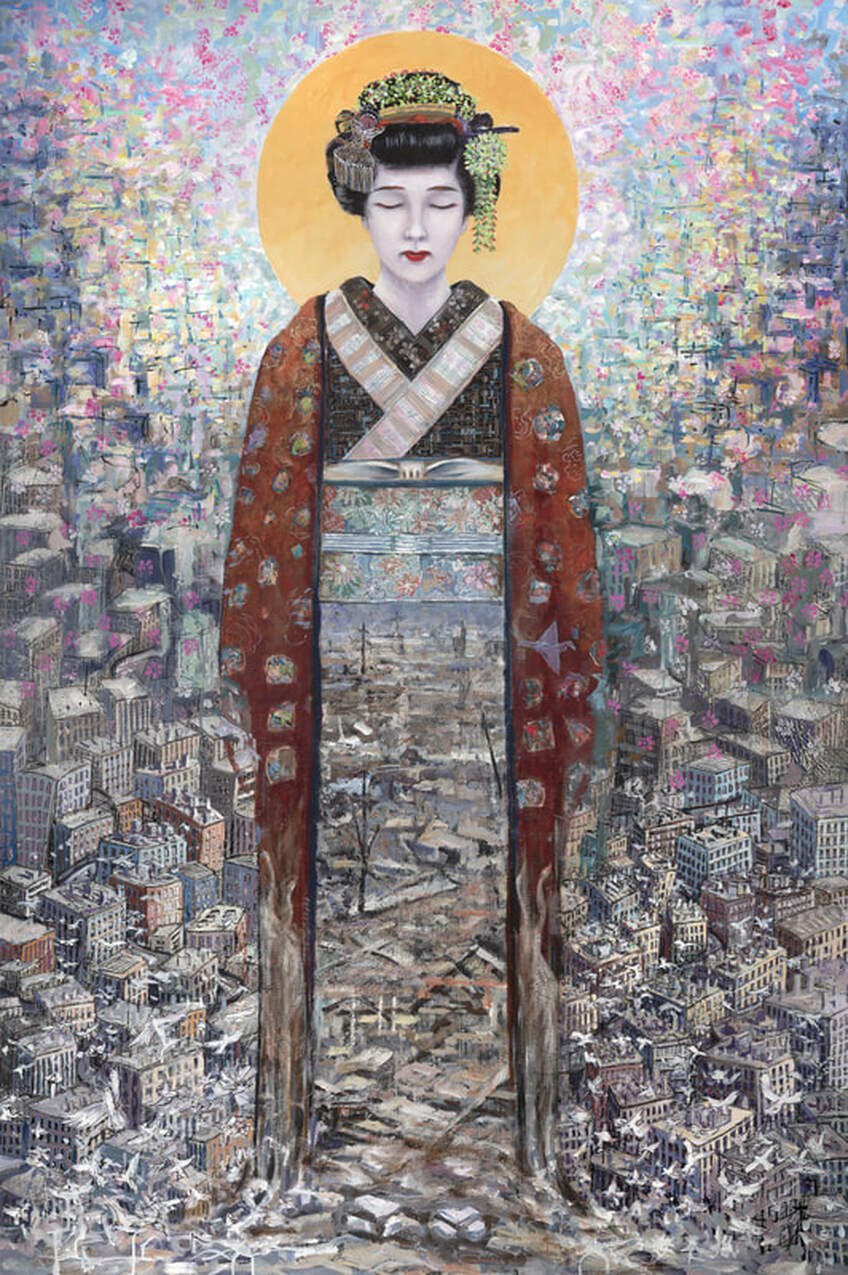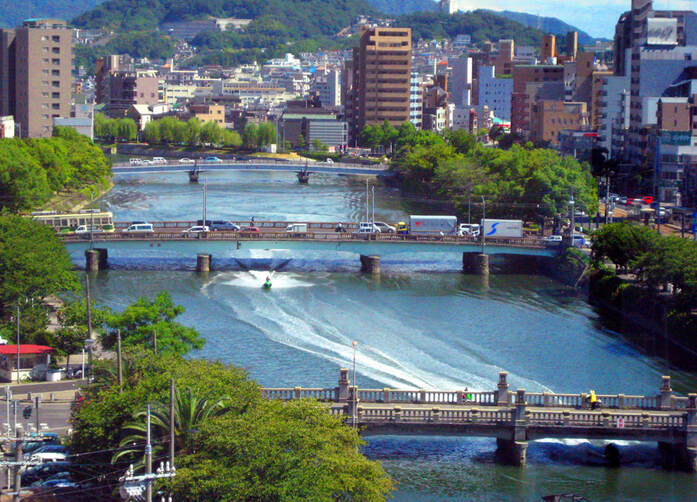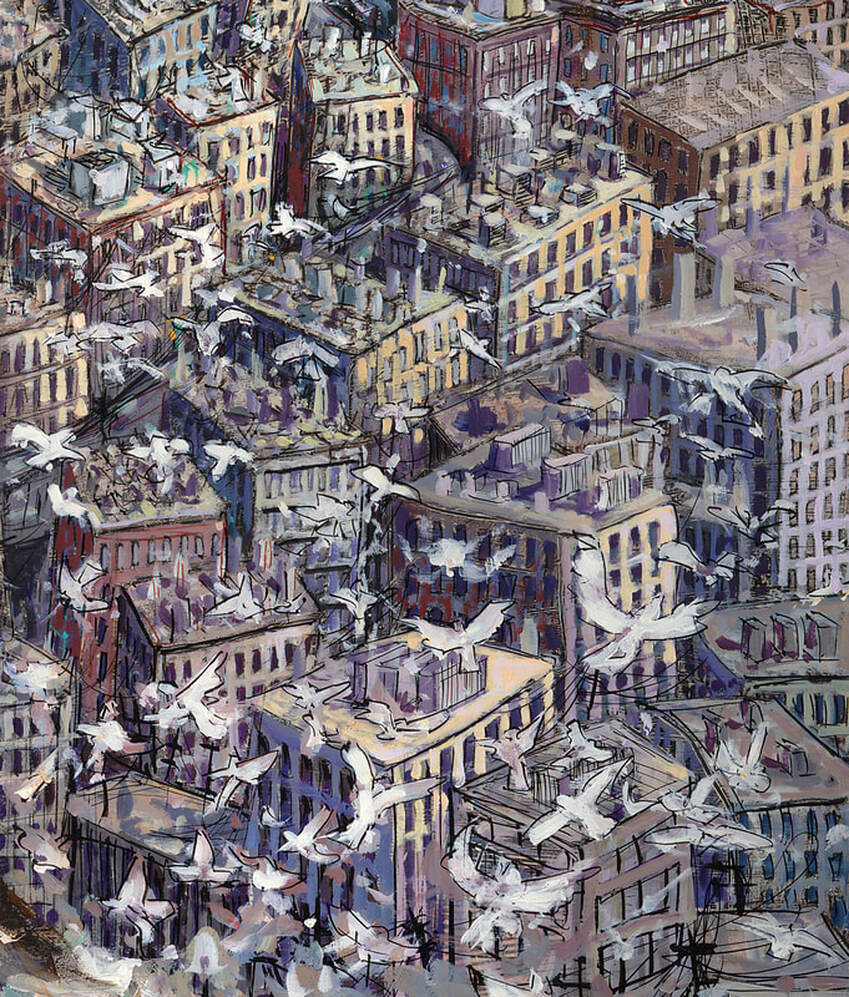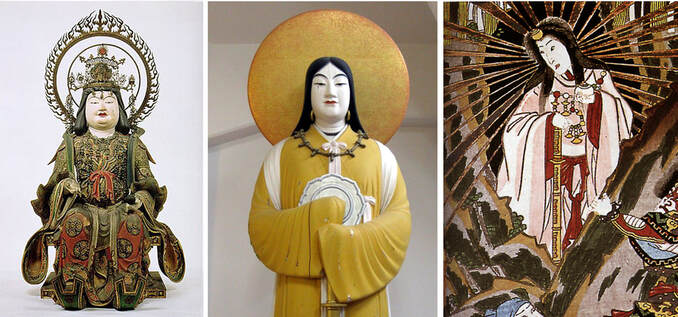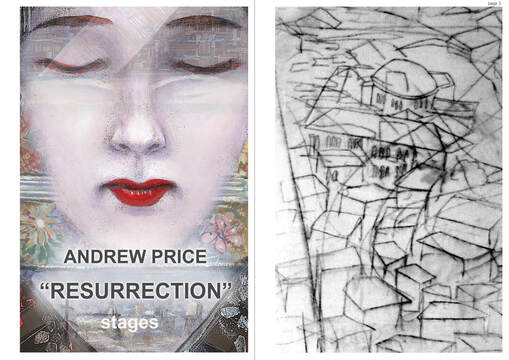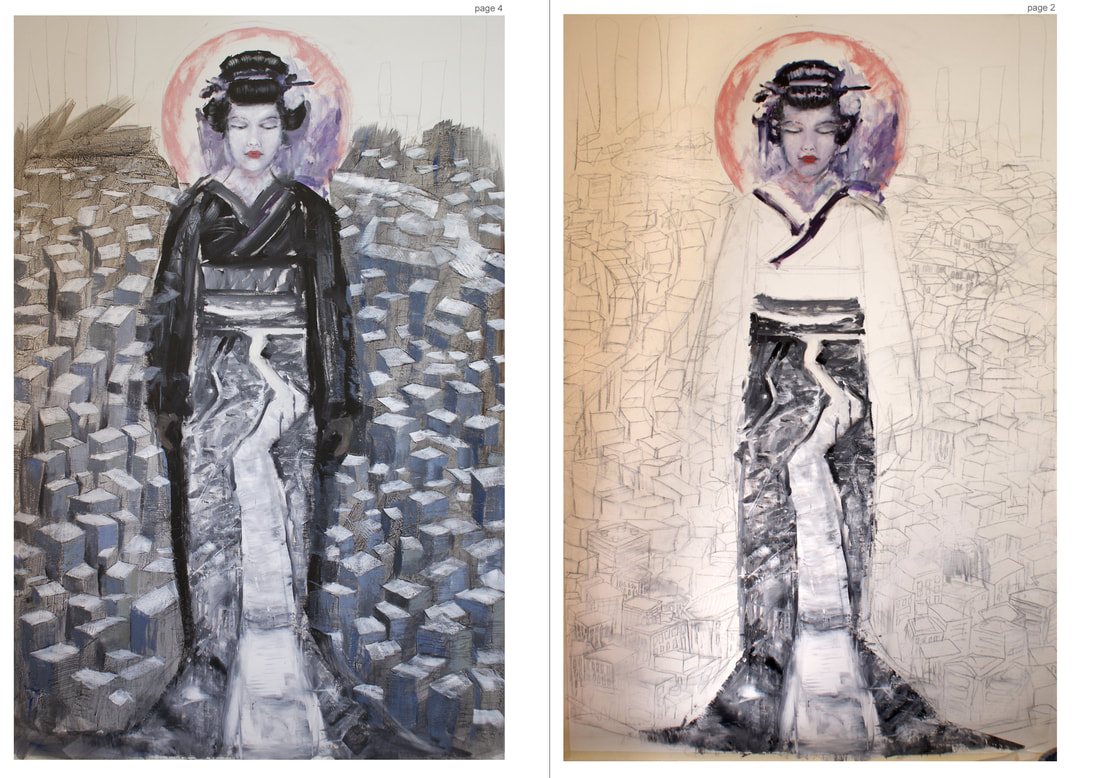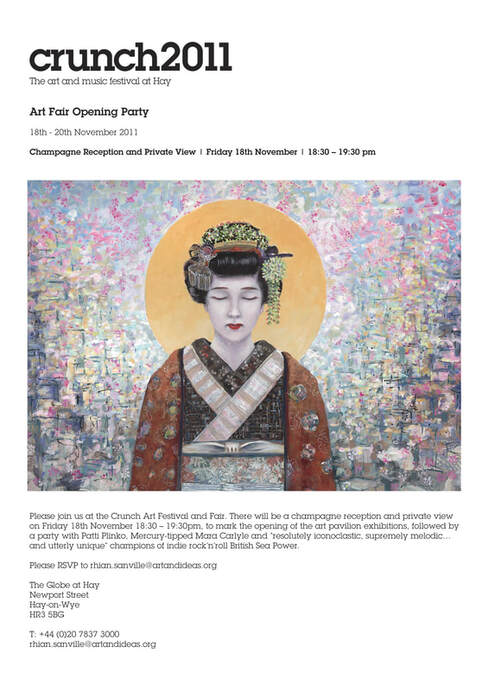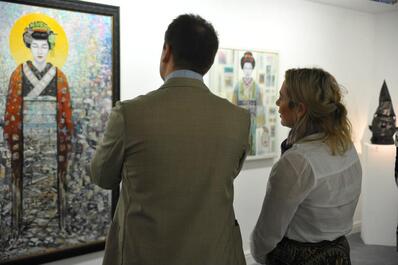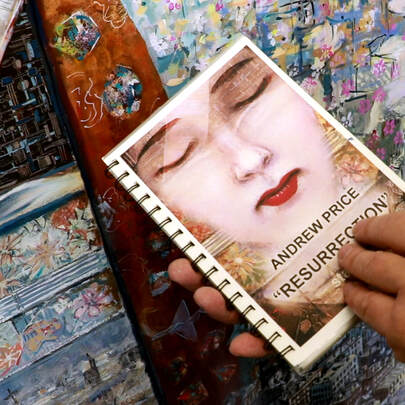RESURRECTION Acrylic 160cm x 107cm
Text from the book
"Behind the Kimono"
"Behind the Kimono"
Evocative, sorrowful, yet full of hope, Resurrection is centred on an event that is sensitive in the hearts of many people; Hiroshima.
Unsurprisingly, the overall approach to this painting was deliberated over fastidiously and was eventually inspired and defined by the artist’s experiences in Hiroshima itself.
After researching various artists’ depictions of war, Andy decided to broach the subject “side-on”. By this he meant portraying the catastrophe through ethereal and humanist imagery rather than the more loaded political paradoxes of the A-Bomb's use whose "reasons" on both sides have complex legitamacies that continue to this day.
Andy recalls a memory of a particularly poignant reaction from a café with a view over the city.
“ I was in Hiroshima for an exhibition. I remember having a coffee in a building high up overlooking one of the rivers. It was a beautiful n day with a deep blue sky and a collections of jet skis gambled criss-cross under the bridges. The café was French in style, the aroma delightful, the music convivial and the hum of conversation relaxed. This was not a city of woe and yet looking through the plate glass across the buildings my eyes alighted on the familiar contours of the hills one sees in old black and white images after the bomb. The scene dissolved in my imagination to the dreadful narratives of untold horror, the same river full of dead floating bodies, a scenes of apocalyptic devastation. Hiroshima, like Columbine, Nanking and Aberfan is one of those places that struggles to escape the ghosts of an unfortunate past. Perhaps it is the imposition of our own psyches, but if there were ever disturbed spirits, one senses them in Hiroshima. It is fitting that a peace park exists for them to rest".
Unsurprisingly, the overall approach to this painting was deliberated over fastidiously and was eventually inspired and defined by the artist’s experiences in Hiroshima itself.
After researching various artists’ depictions of war, Andy decided to broach the subject “side-on”. By this he meant portraying the catastrophe through ethereal and humanist imagery rather than the more loaded political paradoxes of the A-Bomb's use whose "reasons" on both sides have complex legitamacies that continue to this day.
Andy recalls a memory of a particularly poignant reaction from a café with a view over the city.
“ I was in Hiroshima for an exhibition. I remember having a coffee in a building high up overlooking one of the rivers. It was a beautiful n day with a deep blue sky and a collections of jet skis gambled criss-cross under the bridges. The café was French in style, the aroma delightful, the music convivial and the hum of conversation relaxed. This was not a city of woe and yet looking through the plate glass across the buildings my eyes alighted on the familiar contours of the hills one sees in old black and white images after the bomb. The scene dissolved in my imagination to the dreadful narratives of untold horror, the same river full of dead floating bodies, a scenes of apocalyptic devastation. Hiroshima, like Columbine, Nanking and Aberfan is one of those places that struggles to escape the ghosts of an unfortunate past. Perhaps it is the imposition of our own psyches, but if there were ever disturbed spirits, one senses them in Hiroshima. It is fitting that a peace park exists for them to rest".
The memories and experiences of Andy’s visit to Hiroshima gave him the idea to create a tableau work centring on the contrast between construction and destruction. At the onset, he didn’t have a clear idea about what style of kimono or even type of face he was looking for. His only certainty was solemnity married to loss tempered by a brighter future.
The city in the background in the painting is not based on an exact replica of Hiroshima but more a lost surreal space that he said was "A type of city that I imagine in a Haruki Murakami novel or anime film".
The city in the background in the painting is not based on an exact replica of Hiroshima but more a lost surreal space that he said was "A type of city that I imagine in a Haruki Murakami novel or anime film".
A fascinating element to Andy’s creative practice is how his artworks constantly evolve during the painting process. Indeed, the image we see at the base the geisha kimono went through many stages (as illustrated in the final section).
Whilst at the museum, Andy saw an old photograph of small distant figures walking on a desolate road after the bomb and was fascinated at how they simultaneously appeared as insignificant dots and yet demanded we wonder at their individual stories. With this in mind, Andy Built up a collection of bereft figures huddling beneath the kimono.
"I think these would have worked as paintings in their own right. I used ink washes, trying to create the feeling of some calligraphic ageing parchment and the black rain but I couldn’t make them hold within the overall composition. They kept reminding me of the bitter orphans of “want” shrouded beneath Dickens’ dying Ghost of Christmas Present; rather too much “Victorian” sentiment for me”.
Whilst at the museum, Andy saw an old photograph of small distant figures walking on a desolate road after the bomb and was fascinated at how they simultaneously appeared as insignificant dots and yet demanded we wonder at their individual stories. With this in mind, Andy Built up a collection of bereft figures huddling beneath the kimono.
"I think these would have worked as paintings in their own right. I used ink washes, trying to create the feeling of some calligraphic ageing parchment and the black rain but I couldn’t make them hold within the overall composition. They kept reminding me of the bitter orphans of “want” shrouded beneath Dickens’ dying Ghost of Christmas Present; rather too much “Victorian” sentiment for me”.
Andy then came across an old and rare colour photo of the aftermath.
“Wreckage interests me. almost as much as the structure of cities. It's not only the sculpural aesthetic but often the connection they hold to a narrative not only to the culture but sometimes as a marker to specific events, the tree stumps and walkways of Passchendaele, a collapsed colliery tip or the nosecone of a plane in a Scottish field”.
Only much later did a friend in conversation remark to Andy that an x-ray would reveal he had buried these bodies in a virtual tomb and their spiritual release came from the elevated birds rising over the city.
“Wreckage interests me. almost as much as the structure of cities. It's not only the sculpural aesthetic but often the connection they hold to a narrative not only to the culture but sometimes as a marker to specific events, the tree stumps and walkways of Passchendaele, a collapsed colliery tip or the nosecone of a plane in a Scottish field”.
Only much later did a friend in conversation remark to Andy that an x-ray would reveal he had buried these bodies in a virtual tomb and their spiritual release came from the elevated birds rising over the city.
As for the picture plane, a flattened perspective is employed for the city and is extended around the figure as a pattern, the raised paint used to make the nervous edging lines, a technique is also evident in the painting Osaka Time and like both, the drips are expressive of form rather than some vague icon of individualism. In the case of Resurrection, the drips symbolise the black radioactive rain, high condensing moisture falling through a rising cloud of poisonous soot from the fires of the explosion.
Surrounding the central images are symbols of resurrection, cranes and rising doves meeting falling blossom (to the Japanese, the ephemeral nature of beauty and life). Andy after much deliberation settled on depicting the release of doves so common in the Hiroshima peace ceremonies. Concerned about the potential cliché he painted them as fractured chimerical shapes, like torn dismembered souls departing the wreckage towards the healing Spring dawn of the upper sun.
Surrounding the central images are symbols of resurrection, cranes and rising doves meeting falling blossom (to the Japanese, the ephemeral nature of beauty and life). Andy after much deliberation settled on depicting the release of doves so common in the Hiroshima peace ceremonies. Concerned about the potential cliché he painted them as fractured chimerical shapes, like torn dismembered souls departing the wreckage towards the healing Spring dawn of the upper sun.
This rising sun frames the central Geisha, further suggesting resurrection. She is intentionally older and solemn, her eyes downcast in wise meditation. Japan to the West is known as “the land of the rising sun” coming from the Japanese name for Japan (Nihon) the Kanji Ni 日Day and Hon 本 Origin.
Looking from a distance, the blossom surrounding the geisha gives her the appearance of having angelic wings, a pictorial accident that Andy decided to keep.
Looking from a distance, the blossom surrounding the geisha gives her the appearance of having angelic wings, a pictorial accident that Andy decided to keep.
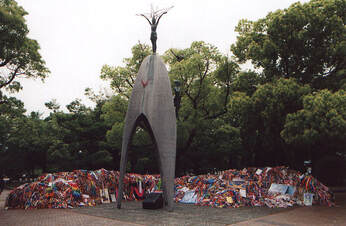
The subdued colouring of the kimono is decorated with a single paper crane. This represents the story of Sadako Sasaki., whose story Andy found most moving from all the competing narratives in the peace park. Sadako was 2 years old and only 2 kilometres from “Ground Zero” when the bomb exploded.
She survived, but 10 years later developed leukaemia from the radiation. Whilst in hospital she began a mission to fold 1000 paper cranes, believing she would be granted a wish buy the Gods. One version of her story had her dying after making 644, with the remainder finished by friends. Another claims she completed them, her dying words being “it is good”.
After her death, Sadako’s friends and schoolmates published a collection of letters in order to raise funds to build a memorial for her and all the children who had died from the effects of the atomic bomb. They were answered and , in 1958, a statue of her holding a gold paper crane was unveiled in the Peace Park, the inscription being “This is our Cry. This is our Prayer. Peace in the world”
She survived, but 10 years later developed leukaemia from the radiation. Whilst in hospital she began a mission to fold 1000 paper cranes, believing she would be granted a wish buy the Gods. One version of her story had her dying after making 644, with the remainder finished by friends. Another claims she completed them, her dying words being “it is good”.
After her death, Sadako’s friends and schoolmates published a collection of letters in order to raise funds to build a memorial for her and all the children who had died from the effects of the atomic bomb. They were answered and , in 1958, a statue of her holding a gold paper crane was unveiled in the Peace Park, the inscription being “This is our Cry. This is our Prayer. Peace in the world”
Andy said “Every year, children leave colourful interwoven streamers of paper cranes at the base of the statue. The dense interwoven colours, their devotion in the folding make that collective transitory colourful pile one of the most moving sights you are likely to see anywhere”.
Once the painting was finished, Andy came across the tale of the Japanese Shinto Goddess, Amaterasu Omikami. He felt there were significant similarities to the symbolic relevancies in his work.
Amaterasu had a beautiful garden in heaven. When she was around, birds sang and flowers bloomed. However, she had a younger mischievous brother, a storm deity who decided one day to wreak havoc with the world and blew strong winds, scattering her beautiful flowers, buildings and trees. Horrified by his actions, the goddess locked herself away in a cave, causing the whole world to be plunged into darkness. Weeks passed without the sun, causing sickness and unhappiness. It was only when she was coaxed from her cave and permitted the sun to shine once again,
Amaterasu had a beautiful garden in heaven. When she was around, birds sang and flowers bloomed. However, she had a younger mischievous brother, a storm deity who decided one day to wreak havoc with the world and blew strong winds, scattering her beautiful flowers, buildings and trees. Horrified by his actions, the goddess locked herself away in a cave, causing the whole world to be plunged into darkness. Weeks passed without the sun, causing sickness and unhappiness. It was only when she was coaxed from her cave and permitted the sun to shine once again,
This is ultimately a tale of female power, a peaceful creative force over male destructiveness. In many ways it sums up the overriding theme of the artwork, a journey from Amaterasu to the little Sasaki. Although the base of the painting is saturated with dark and murky colours, the colours rise from the ashes towards falling blossom, towards hopefulness/ From the destruction hope breaks free.
Respectful, informative and hopeful, Resurrection recognises the destruction and contradictions of war, but in the final analysis seeks a sense of the redemptive spirit as a guide to future reconciliation.
Respectful, informative and hopeful, Resurrection recognises the destruction and contradictions of war, but in the final analysis seeks a sense of the redemptive spirit as a guide to future reconciliation.
Further Photos

